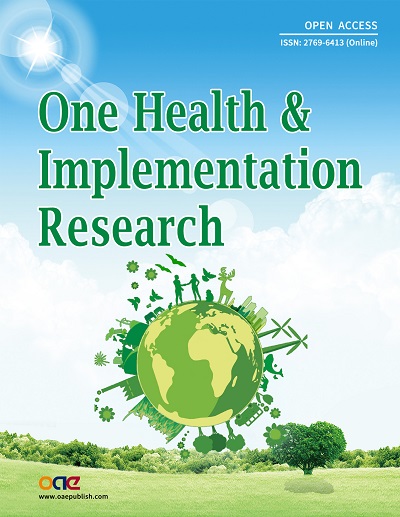A Special Interview with Prof. Hongzhou Lu — A Fighter for Public Health
On July 14th, 2024, the Editorial Office of One Health & Implementation Research (OHIR) had the honor of conducting an exclusive interview with Prof. Hongzhou Lu, President of Shenzhen Third People's Hospital, Shenzhen, China, and a Fellow of the American College of Microbiology.
Prof. Lu shared insights into his latest medical research breakthroughs, strategies for achieving the goal of ending AIDS by 2030, and proactive measures for potential future pandemics caused by Disease X. Moreover, he offered valuable advice for young scholars and suggestions for advancing our journal.
Take a brief look at the questions and highlights:
1. Heartiest congratulations on the formal confirmation of Bacteroides luhongzhouii Ge et al. 2021 by the International Committee on Systematics of Prokaryotes (ICSP). You are now the third Chinese scientist to receive such recognition. Could you please share with our readers the process behind discovering this new Bacteroides strain and the related research findings?
- The new Bacteroides was discovered by Prof. Jianguo Xu.
- Prof. Xu named the strain after me in recognition of my significant contributions to microbiology.
2. Congratulations on your latest research findings on 3CL protease inhibitors for COVID-19 published in The Lancet. Could you provide detailed information about the phase II and III clinical trials of this drug and its efficacy in clinical treatment?
- Objective: To verify the efficacy and safety of oral administration of GST-HG171 plus Ritonavir in COVID-19 patients.
- Method: multi-center RCT
- Sample: 1,246 COVID-19 patients from 47 centers
- Procedure: Patients were divided into two groups: the treatment group receiving GST-HG171 (150 mg) plus Ritonavir (100 mg), and a 1:1 matched placebo control group.
- Results: (1) In terms of efficacy, the treatment group showed a shorter median time to recovery of clinical symptoms compared to the placebo control (13 days versus 15 days); (2) In terms of safety, there was no significant difference in the incidence of adverse events between the treatment and placebo groups.
3. We know that you participated in the 2024 Medical Technology Achievement Innovation and Transformation Roadshow Conference on May 16th and presented the latest achievements in medical technology regarding super-resistant bacteria phages and monkeypox outbreaks. Could you provide a brief overview of the presentation?
Regarding the phage treatment:
- Earth hosts numerous species of phages, each with distinct origins, facilitating extensive studies on clinical bacterial infections, chronic diseases, and agricultural pathogens.
- In collaboration with prominent phage research centers in China, such as BGI Research and Zhongshan Hospital of Fudan Univ, my research team has established a large phage-related databank containing data on over 2,500 phages.
- Currently, we are conducting fundamental research, including pharmacokinetic evaluations and safety assessments of various phages in different mammalian species, and verifying the efficacy of phage treatment in COPD animal models.
- Clinically, we have treated about 200 cases involving complex bacterial infections. The drug-resistant bacteria treated include Klebsiella pneumoniae, baumannii, Pseudomonas aeruginosa, and Stenotrophomonas maltophilia, among others, affecting sites such as the lungs, urethra, and wounds. Various departments, such as Respiratory Medicine, ICU, and Transplantation, have contributed to these phage-related studies.
- Our preliminary studies have confirmed the efficacy and safety of phage treatment for treating complex infections. Compared to conventional antibiotic-based therapies, phage treatment has demonstrated superior effectiveness and safety, particularly against infections involving super-resistant bacteria.
- Looking ahead, our focus will be on translating phage treatment from bench to bedside. This includes refining phage manufacturing techniques, establishing clinical cohorts, and carrying out more clinical trials.
We hope phage treatment can be widely used in the near future.
4. You've dedicated over thirty years to HIV research, accumulating rich experience in diagnosis, treatment, and prevention. The Global HIV Prevention Coalition's “HIV Prevention Road Map 2025” aims to reduce annual new HIV infections to below 370,000 by 2025, steering HIV prevention toward ending the epidemic and achieving the goal of ending AIDS by 2030. Could you share the latest research findings on pre-exposure prophylaxis (PrEP) for HIV and the efforts needed in the coming years to achieve these goals?
Great progression has been made in AIDS treatment and prevention.
- The application of new antiviral drugs and the promotion of novel prevention and control methods in high-risk groups have gradually reduced AIDS incidence. Notably, PrEp, involving the prophylactic use of antiviral drugs in HIV-negative people before potential exposure, has played a crucial role.
Regarding PrEP:
(1) Efficacy: The effectiveness of PrEP in preventing HIV infection has been well documented, especially among high-risk groups, such as MSM, sex workers, and people who inject drugs.
(2) Drug compliance. The effectiveness of PrEP heavily relies on drug compliance. Individuals with high drug compliance are more likely to benefit from PrEP, while poor compliance might lead to new HIV infections. Addressing this, the development of a long-acting injectable formulation like Cabbovir (CAB-LA) is an urgent task.
Efforts to achieve the goal of ending AIDS by 2030 include:
(1) Increasing availability and acceptance of PrEP;
(2) Enhancing monitoring and support for HIV-related indicators;
(3) Research and development of new screening biomarkers, therapeutic targets, and drugs;
(4) Promoting societal participation;
(5) Combating AIDS-related inequality and discrimination.
5. You have played a pivotal role in managing outbreaks of SARS, H1N1, H7N9, Ebola, and COVID-19, earning the title of “A Fighter for Public Health.” Based on your years of experience and research, what preparations can be made proactively from the One Health perspective regarding the WHO’s concept of Disease X and potential pandemic risks?
- “Disease X” represents a serious international epidemic caused by a pathogen not previously known to affect humans.
- It is characterized by two key features: international epidemic potential and an uncertain pathogen.
- Insights gained from combating COVID-19 can provide valuable strategies.
- Governments and health authorities should remain vigilant and undertake necessary preparations.
6. We know that Shenzhen National Clinical Research Center for Infectious Diseases is recruiting postdoctoral researchers to study the mechanisms of emerging infectious diseases, the functional cure of AIDS, and the mechanisms of tuberculosis coexisting with AIDS. What advice do you have for young scholars pursuing a career in this field?
- Develop strong English language skills;
- Maintain curiosity about scientific problems in their fields;
- Enhance their ability to quickly find and grasp the main value of relevant literature and stay updated on field advancements;
- Utilize AI-assistant technologies like ChatGTP;
- Cultivate the two “I”s: independence and international perspective;
- Foster a daily habit of reading literature.
7. OHIR is in its early development stage. As the Associate Chief Editor, do you have any suggestions for its further development?
- Ensure high-quality manuscripts;
- Establish a comprehensive database of the peer reviewers;
- Aim to be indexed in major scientific databases such as WOS, Scopus, PMC, and Google Scholar.
Personal Introduction:

Prof. Hongzhou Lu, Chief Physician, Chair Professor at Southern University of Science and Technology; Ph.D. Supervisor in Internal Medicine, Public Health Management, and Nursing; Deputy Secretary of the Party Committee and President of Shenzhen Third People’s Hospital; Director of the National Clinical Research Center for Infectious Diseases; Fellow of the American Society for Microbiology; Head of the first Public Health Expert Group for Epidemic Prevention and Control in Shenzhen; Changjiang Scholar of the Ministry of Education, National Talents Project candidate, "Outstanding Young and Middle-aged Expert with Outstanding Contributions," recipient of the State Council's Special Allowance; Editor-in-Chief of iLABMED; Former Assistant to the President of Huashan Hospital Affiliated to Fudan University, Former Party Secretary of Shanghai Public Health Clinical Center; World’s Top 2% Scientists in the Career-Long impact in 2021, 2022, and 2023 by Stanford University.
Academic Positions:
- Director of the WHO Collaborating Center for Clinical Management and Research of Emerging Infectious Diseases
- Member of the Antiviral Group (AVG) of the International Society for Influenza and Other Respiratory Virus Diseases (ISIRV)
- Member of the National Expert Committee on Disease Prevention and Control, the National Health Commission’s expert panels on AIDS, Influenza, Ebola Virus Disease, and Infectious Disease Quality Control Centers
- Member of the national COVID-19 treatment expert group and the support team for overseas anti-epidemic expert groups
- Head of the AIDS and Tuberculosis Committee of the Chinese Association of STD and AIDS Prevention and Control and Head of the Tuberculosis Group
- Deputy Leader of the AIDS Professional Group of the Infectious Disease Branch of the Chinese Medical Association
- Former Chairperson of the Tropical Medicine and Parasitology Branch of the Chinese Medical Association and Head of the AIDS Group
- Chairperson of the Infectious Disease Branch of the Western Returned Scholars Association (WRSA)
- Former Chairperson of the Infectious Disease Branch of the Shanghai Medical Association
Research Achievements:
- Principal investigator of four National Science and Technology Major Projects of China, two national key R&D programs, several National High-tech R&D Program of China (863 Program), and seven National Natural Science Foundation of China projects (including one Major Program), as well as 59 research projects funded by the Gates Foundation and other national key clinical specialty projects
- Published over 500 papers as the first author or corresponding author in domestic and international journals, including 360 papers in SCI-indexed journals such as Nature, New England Journal of Medicine, Lancet Microbe, and Science Translational Medicine
- Authored and edited 15 professional reference books
Awards
- Recipient of the French National Academy of Sciences “Shabank-Dubose” Award (2020)
- National Science and Technology Special Award
- “Silver Snake Award” of the Shanghai Health System
- First Prize of Shanghai Scientific and Technological Achievements and First Prize of Shanghai Medical Science and Technology
- More than ten national and provincial scientific and technological achievement awards
- Holder of 15 patents
- Recipient of the “People’s Physician • Outstanding Achievement” award in 2022
Prof. Lu is leading a Special Issue titled “One Health Approach to Emerging and Re-emerging Infectious Diseases” in our journal OHIR. We are calling for high-quality papers for this Special Issue. For more details, please visit: https://www.oaepublish.com/specials/ohir.1979
Editor: Phoebe Zhao
Language Editor: Catherine Yang
Production Editor: Yan Zhang
Respectfully submitted by the Editorial Office of One Health & Implementation Research





